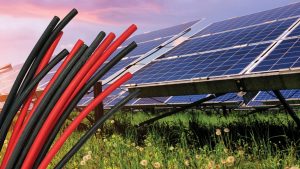Solar Cables Manufacturers & Exporters
Solar Cables Manufacturers & Exporters
The solar power systems that create electricity use special wires to convey the energy they produce. These wires, known as solar cable or PV wire, must be able to withstand extreme weather conditions and last for years.
Unlike normal DC cables, which have a lifespan of five to eight years, solar cable has a minimum 25-year guranteed life. This is why it requires a different set of materials than normal wires do.
Conductor
Solar cables must be able to withstand thermal and mechanical loads. This is particularly important since they are often exposed to harsh environmental conditions, such as temperature fluctuations and direct sunlight. This is why they are made with durable materials, including copper or aluminum conductors and insulation that can withstand high temperatures. In addition, they must be designed to meet national codes and requirements. For example, they should be stranded wire rather than solid wire, which has a higher resistance to mechanical stress and can increase the risk of fires.
To choose the right cable for your PV system, first determine the maximum current that it will be rated for. Then, use a cable sizing calculator to calculate the appropriate wire gauge. This will help you avoid overheating and a voltage drop, which can reduce efficiency and increase your electricity bill.
Next, consider the climate and environmental conditions where you will install the cables. For instance, if your solar panel system is in a desert environment, you will need a cable with a high UL rating. Additionally, if your system will be subject to direct sunlight, you will need a cable with an UV & Ozone resistant jacket. Finally, it is also important to choose a cable that contains low or no halogen, as these will be safer in the event of a fire.
Insulation
Choosing a wire with the proper insulation is essential to ensure the safety and longevity of solar cables. The insulation should be able to resist high temperatures, UV light, and other harsh conditions. Additionally, the insulation should be resistant to chemicals and moisture.
There are a number of different types of insulation available for solar cables, including THHN, THWN, UF, USE-2, and PV. Each type of insulation is suitable for different conditions. For example, THHN and THWN insulation are designed for dry indoor environments, while USE-2 and PV wire are ideal for ungrounded PV systems that will be exposed to harsh weather conditions.
Solar cable manufacturer & insulation is also LSHF, which means that it does not contain any halogens. This is important because halogens can suffocate people and cause fires. Furthermore, halogens produce toxic gases such as carbon monoxide and hydrogen chloride. For these reasons, LSHF is the preferred type of insulation for PV cables.

Jacket
Solar cables and wires are vital to the proper functioning of a solar energy system. They carry the current from the photovoltaic panels to the inverter, which converts the DC power into AC energy for use in homes and businesses. Without the proper wiring, the solar system can lose energy efficiency or cause dangerous electrical resistance. It is important to choose a quality cable that complies with industry standards and is properly installed to ensure safety and performance.
There are many factors to consider when choosing a solar cable, including the number of insulated conductors and the type of material used. For example, a single-core cable has a single conductive copper or aluminum core surrounded by insulation and an outer sheath. This type of cable is commonly used for smaller solar systems. Multi-core PV cables, on the other hand, have multiple insulated conductors in a single sheath and are designed for larger-scale solar installations.
The size of the conductor also impacts the cable’s current-carrying capacity. To determine the appropriate cable gauge for your solar system, consult a cable sizing chart or online calculator. Other considerations include operating temperatures, environmental conditions, and local electrical codes. Also, look for a cable that is rated for outdoor installation and can withstand high levels of UV radiation. It is also a good idea to buy a cable that has fireproof and short circuit protection features.
Sheath
As the lifelines of solar energy systems, solar cables ensure that sun-generated electricity reaches its intended destination. These specialized wires are designed to withstand a range of environmental factors, including temperature and UV radiation. They also need to be highly durable and reliable to ensure a smooth, uninterrupted flow of power. To meet these requirements, the best solar cable manufacturers use high-quality materials and adhere to rigorous quality standards.
Solar cables are usually made from stranded or solid metal conductors that are insulated with a protective sheath. They can be used in either AC or DC circuits, depending on the needs of the system. They are available in a variety of lengths and connector types, and are typically color-coded for easy identification and installation. This makes it easy for installers to identify the correct voltage and current levels.
The sheath of a solar panel cable can be made from plastic, rubber, or other material. It is important to look for a sheath that is durable and will protect the wires from corrosion. It should also be fireproof and capable of working at a wide range of temperatures. Finally, it should be resistant to rodents and other pests.
Solar panels also need to be connected to other components in the system, such as inverters and junction boxes. These connections require special solar cables, which are available in different lengths and connector types. Some solar cables even come pre-assembled with connectors, making it easier and more efficient to install them.